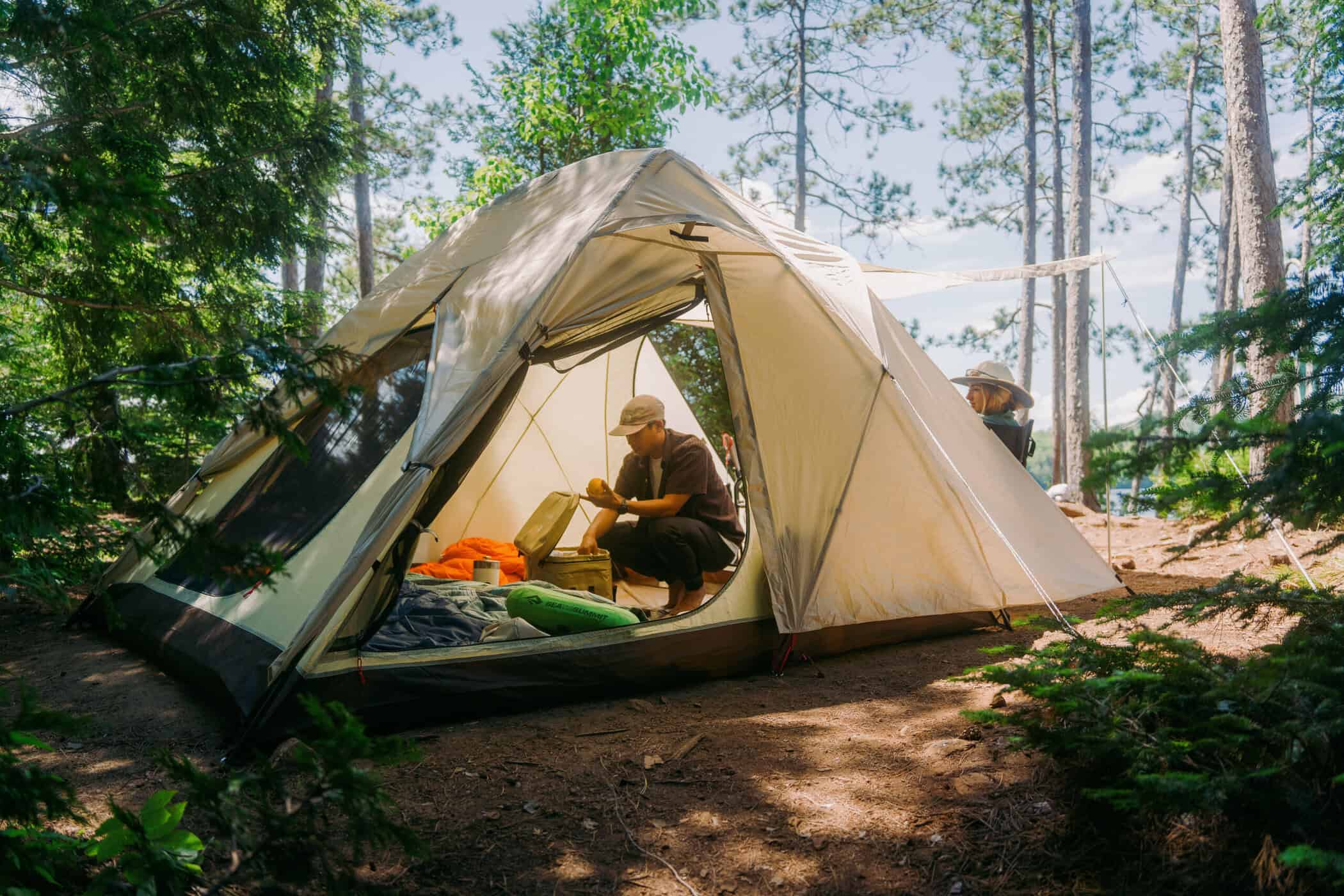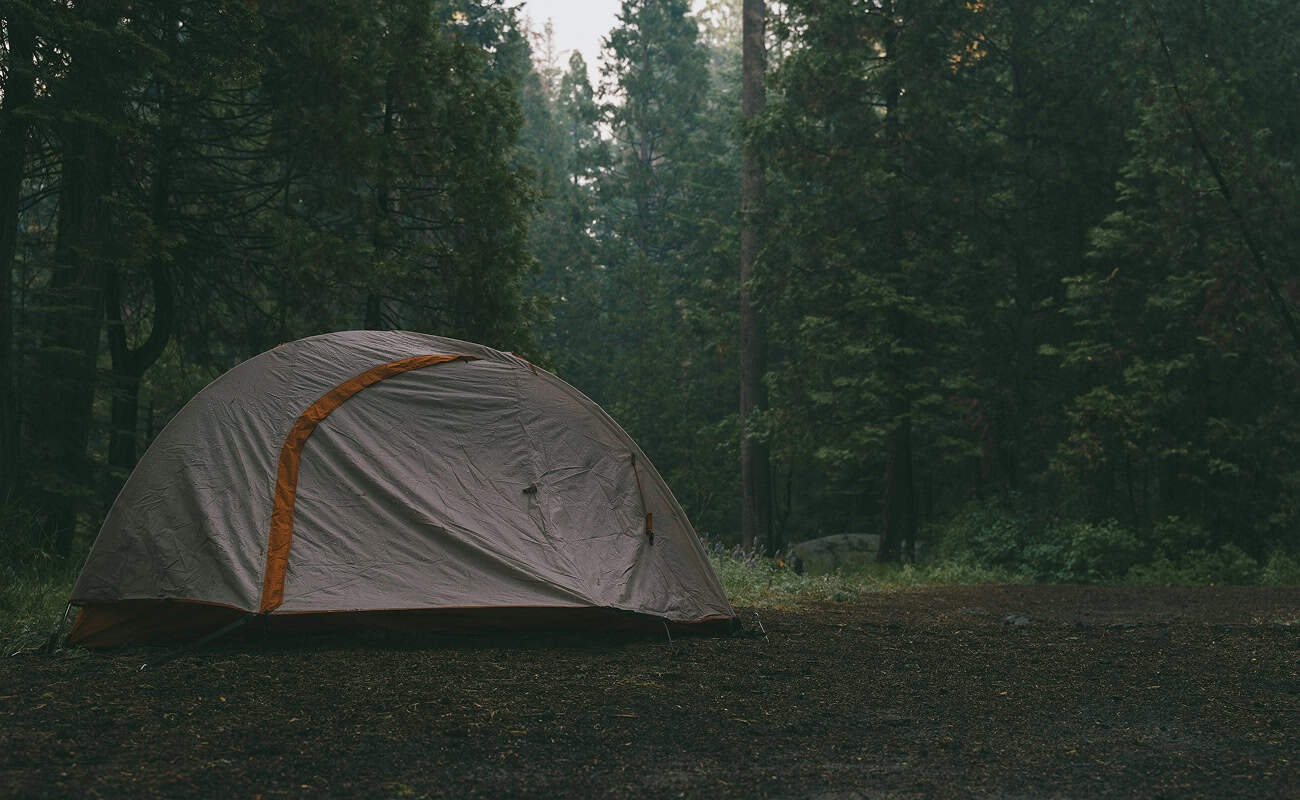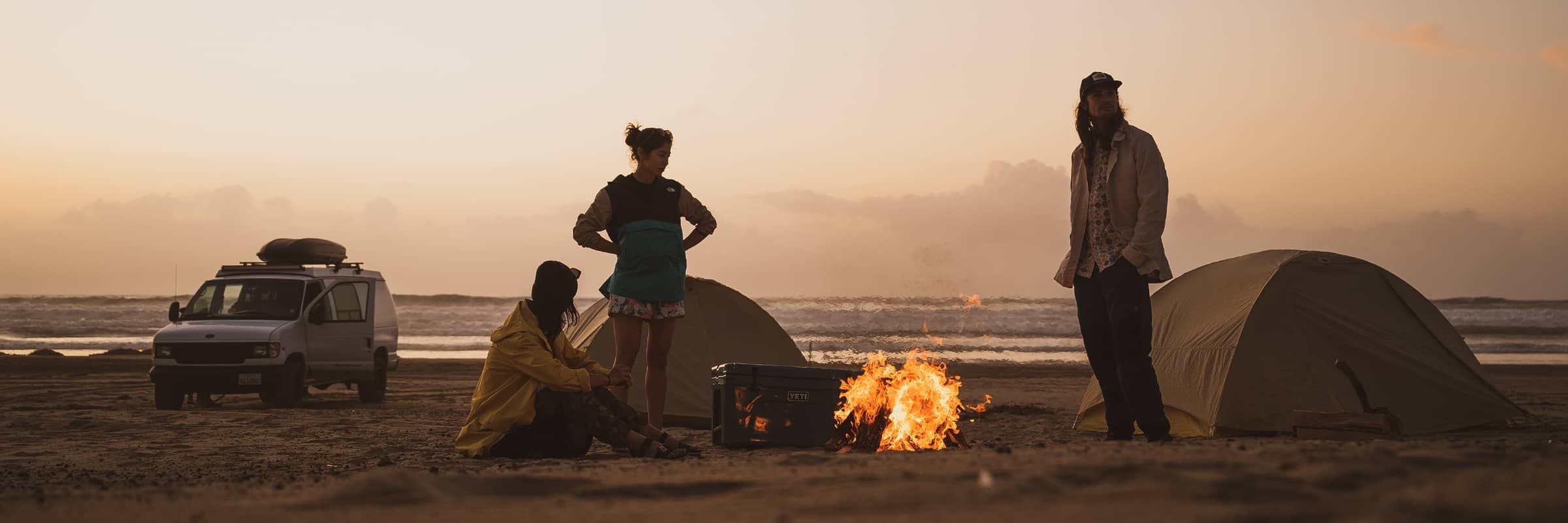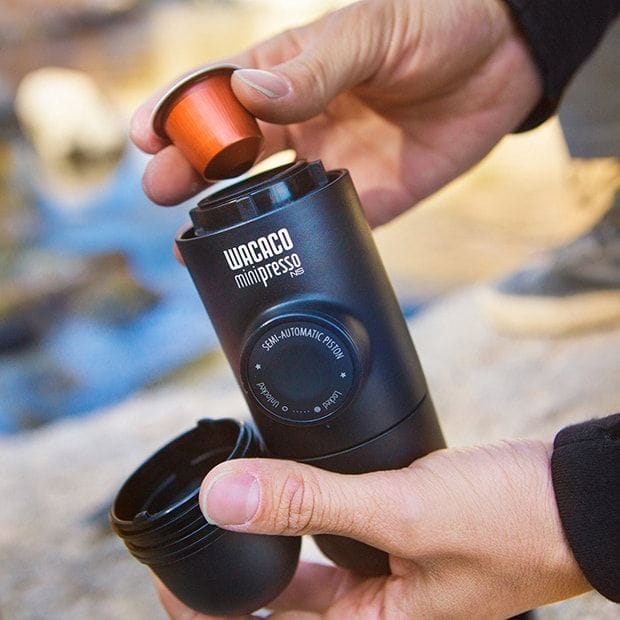Who doesn’t want a cabin in the woods? Better yet, who doesn’t want a portable cabin in the woods? OK, maybe a tent isn’t quite as luxurious as a cabin. Nevertheless, its spartan nature doesn’t mean it can’t be a safe and comfy place you can call home in the backcountry. Today, we take a look at the top backpacking and backpacking tents of the year.
We’ve evaluated tents based on price, weight, packability, functionality, versatility, and durability. Read on to see our favourites.
The Top Backpacking Tents Reviewed
- Lorem ipsum dolor<\/li>
- Lorem ipsum dolor<\/li>
- Lorem ipsum dolor<\/li><\/ul>","_id":"7bdda7f"},{"feature":"
- Lorem ipsum dolor<\/li>
- Lorem ipsum dolor<\/li>
- Lorem ipsum dolor<\/li><\/ul>","_id":"af6008a"}],"single_product_id":null,"cta_1_url":null,"cta_2_url":null,"credit":null,"limit":null,"collection_link":null}
Best Ultralight Backpacking Tents
For Which Type of Backpacker
The Big Agnes Tiger Wall UL2 Tent is built for ultralighters who want the best of both worlds: minimal weight and real-world livability. Its side-entry design and dual vestibules make it especially appealing for solo hikers who want extra space—or lightweight partners who prefer their own exit. It’s a go-to for fast-and-light multi-day missions where comfort still counts.
Why We Picked It
We picked the Tiger Wall UL2 for its perfect balance of weight, simplicity, and trail-tested comfort. During a humid 3-day loop in Parc National de la Jacques-Cartier, it pitched quickly—even in awkward campsites—thanks to the intuitive single-pole design. The semi-freestanding structure held steady through wind and rain, while the vestibules kept gear dry and accessible.
What stood out was the fabric performance: the proprietary HyperBead material repelled water impressively without sag, and ventilation through the low vent and mesh panels kept things breathable despite damp conditions. With a sub-1 kg trail weight and 2-door convenience, this tent feels dialed in for serious hikers who count grams but still want some breathing room.
Features and Benefits
- Ultralight Build: Just 2 lb 3 oz (992 g) trail weight with a compact 18" pack size
- HyperBead Fabric: Lighter, stronger, and 25% more waterproof than traditional options
- Semi-Freestanding: Single-pole architecture for fast, flexible pitches
- Dual Access: Two doors and two 8 sq. ft. vestibules for convenient storage and exits
- Ventilation Focused: Mesh canopy, low vent, and dual-slider vestibule zips minimize condensation
- Interior Storage: Oversized 3D ceiling pocket and quick stash door keeper
- Eco-Conscious: PFAS-free waterproofing, recycled materials, and solvent-free seam taping
Price: 0.00$
Brand Name | Product Type
- Lorem ipsum dolor<\/li>
- Lorem ipsum dolor<\/li>
- Lorem ipsum dolor<\/li><\/ul>","_id":"3c8d0b6"},{"feature":"
- Lorem ipsum dolor<\/li>
- Lorem ipsum dolor<\/li>
- Lorem ipsum dolor<\/li><\/ul>","_id":"20bd408"}],"single_product_id":"","cta_1_url":{"url":"https:\/\/www.altitude-sports.com\/products\/big-agnes-tiger-wall-ul2-tent-llll-bag-ttwul225","is_external":"on","nofollow":"","custom_attributes":""},"cta_2_url":{"url":"","is_external":"","nofollow":"","custom_attributes":""},"credit":null,"limit":null,"collection_link":null}
For Which Type of Backpacker
The NEMO Hornet OSMO Ultralight 2-Person Backpacking Tent is made for ounce-counters and fastpackers who refuse to compromise on comfort. It’s ideal for thru-hikers, solo trekkers sharing space, or minimalist duos who want full-featured protection and livability in a tent that weighs little more than a water bottle.
Why We Picked It
We picked the Hornet OSMO 2P because it hits that rare sweet spot: sub-2.5 lb weight, livable design, and eco-forward construction. On a late spring test trip in the Charlevoix backcountry, it impressed us with its fast setup, clever space-expanding design, and weather resilience. The Flybar pole clip and corner struts genuinely increased interior volume, keeping our sleeping bags off the wet walls and making the tent feel bigger than its specs.
What also stood out was the quality of the OSMO fabric. It didn’t sag after rain and dried out noticeably faster than traditional silnylon. Add in the Nightlight Pockets for warm ambient glow, and this tent felt more like an intentional design solution than a stripped-down compromise.
Features and Benefits
- Ultralight Build: Weighs just 2 lb 1 oz (948 g) for true minimalists
- Spacious Interior: Volumizing Flybar and corner struts expand foot and headroom
- OSMO Fabric: 100% recycled, PFAS-free, with 3x less wet stretch
- Dual Access: Two large doors and vestibules for gear storage and easy exits
- Semi-Freestanding: Minimal pole setup with fast pitch time
- Smart Storage: Nightlight Pockets, internal gear pockets, and Gatekeeper tiebacks
- Compact Stuff Sack: Divvy Cube packs down flat and lets you split weight with a partner
Price: 0.00$
Brand Name | Product Type
- Lorem ipsum dolor<\/li>
- Lorem ipsum dolor<\/li>
- Lorem ipsum dolor<\/li><\/ul>","_id":"3c8d0b6"},{"feature":"
- Lorem ipsum dolor<\/li>
- Lorem ipsum dolor<\/li>
- Lorem ipsum dolor<\/li><\/ul>","_id":"20bd408"}],"single_product_id":"","cta_1_url":{"url":"https:\/\/www.altitude-sports.com\/products\/big-agnes-tiger-wall-ul2-tent-llll-bag-ttwul225","is_external":"on","nofollow":"","custom_attributes":""},"cta_2_url":{"url":"","is_external":"","nofollow":"","custom_attributes":""},"credit":null,"limit":null,"collection_link":null}
For Which Type of Backpacker
The MSR Hubba Hubba LT 2-Person Backpacking Tent is built for ultralight backpackers and weekend adventurers who prioritize space, weather protection, and fast setup—without carrying extra weight. Its generous interior and dual vestibules make it an ideal companion for pairs looking to share gear, sleep comfortably, and stay dry through unpredictable weather.
Why We Picked It
We chose the Hubba Hubba LT for its smart design and reliable performance in variable conditions. During our testing in early spring in the Laurentians, setup was quick even under light rain—thanks to its symmetrical pole structure and intuitive layout. Breathability stood out too: the micromesh kept condensation at bay while allowing us to stargaze comfortably on clear nights.
Durability was another win. The DAC poles held steady in gusty wind, and the new PFAS-free DWR coating effectively shed water after hours of steady drizzle. At just 3 pounds, this tent punched far above its weight in livability, making it a top pick for those who want lightweight gear that doesn’t sacrifice comfort or weatherproofing.
Features and Benefits
- Roomy Design: Rectangular 32 sq. ft. floor fits two wide pads, with 40" of headroom
- Ultralight Performance: Just 3 lb (1.36 kg) minimum weight
- Weather Ready: Waterproof floor and rainfly, PFAS-free DWR, taped seams
- Dual Vestibules: 16 sq. ft. of exterior storage with StayDry doors and rain gutters
- Superior Ventilation: Micromesh canopy minimizes condensation and allows stargazing
- Eco-Friendly Fabric: Solution-dyed materials cut water use and emissions by 80%
- Fast Setup: Symmetrical design with unified hub-and-pole system
Price: 0.00$
Brand Name | Product Type
- Lorem ipsum dolor<\/li>
- Lorem ipsum dolor<\/li>
- Lorem ipsum dolor<\/li><\/ul>","_id":"3c8d0b6"},{"feature":"
- Lorem ipsum dolor<\/li>
- Lorem ipsum dolor<\/li>
- Lorem ipsum dolor<\/li><\/ul>","_id":"20bd408"}],"single_product_id":"","cta_1_url":{"url":"https:\/\/www.altitude-sports.com\/products\/big-agnes-tiger-wall-ul2-tent-llll-bag-ttwul225","is_external":"on","nofollow":"","custom_attributes":""},"cta_2_url":{"url":"","is_external":"","nofollow":"","custom_attributes":""},"credit":null,"limit":null,"collection_link":null}
For Which Type of Backpacker
The North Face Trail Lite 2 Tent is built for weekend warriors and casual backpackers who want comfort and simplicity without overcomplicating their kit. With a generous interior, smart storage, and intuitive setup, it’s ideal for couples, first-timers, or anyone upgrading from a clunky car-camping setup to a true backcountry-ready shelter.
Why We Picked It
We chose the Trail Lite 2 for its balance of livability, durability, and price. On an early-season overnight in Mont-Tremblant, this tent handled rough weather and uneven ground without flinching. The symmetrical pole structure and pre-bent corners made setup smooth, even after dusk. Once pitched, the tent’s roomy headspace and oversized vestibules made it feel far more spacious than the weight suggests.
We also appreciated the little things: ceiling pockets fit headlamps and phones perfectly, and the oversized doors meant no awkward climbing over your tentmate. With non-PFC DWR coatings and a flame-retardant-free build, it’s also one of the more eco-conscious choices in its class—without a premium price tag.
Features and Benefits
- Spacious Interior: Pre-bent poles and tall peak height maximize livable space
- Intuitive Setup: X-style pole layout with easy clips for fast pitching
- Dual Vestibules: 29.75 sq. ft. of external storage for bulkier gear
- All-Weather Ready: Rainfly integrates with pole structure to stand up to storms
- Smart Storage: Ceiling and side pockets for headlamps, tablets, and essentials
- Eco-Friendly: Non-PFC DWR coating and flame-retardant-free materials
- Great Value: Sub-5 lb trail weight (2.01 kg) with full-feature performance
Price: 0.00$
Brand Name | Product Type
- Lorem ipsum dolor<\/li>
- Lorem ipsum dolor<\/li>
- Lorem ipsum dolor<\/li><\/ul>","_id":"3c8d0b6"},{"feature":"
- Lorem ipsum dolor<\/li>
- Lorem ipsum dolor<\/li>
- Lorem ipsum dolor<\/li><\/ul>","_id":"20bd408"}],"single_product_id":"","cta_1_url":{"url":"https:\/\/www.altitude-sports.com\/products\/big-agnes-tiger-wall-ul2-tent-llll-bag-ttwul225","is_external":"on","nofollow":"","custom_attributes":""},"cta_2_url":{"url":"","is_external":"","nofollow":"","custom_attributes":""},"credit":null,"limit":null,"collection_link":null}
For Which Type of Backpacker
Ideal for ultralight enthusiasts who don’t want to sacrifice comfort or livable space, the Big Agnes Copper Spur UL2 Tent is made for serious backpackers tackling multi-day routes. With a freestanding design and smart storage features, it’s a strong choice for solo hikers wanting elbow room—or a pair seeking lightweight luxury in the backcountry.
Why We Picked It
The Copper Spur UL2 earned a top spot in our testing for its balance of weight, weather protection, and interior space. We set it up on a wind-swept ridge above Lac Monroe, where the freestanding frame held firm and the vestibules provided dry entry points even during evening showers. Ventilation was another standout—especially with the dual low and high vents that reduced condensation despite humid conditions.
We also appreciated the tent’s thoughtful layout. The oversized bin pocket and multiple gear loops made it easy to keep things organized, and the awning-style doors gave us shaded airflow when the sun came out. It’s clear this tent was built by people who actually spend nights outside.
Features and Benefits
- Ultralight Comfort: Trail weight just 2 lb 10 oz (1.18 kg), ideal for long hauls
- Durable and Waterproof: HyperBead fabric is stronger, lighter, and PFAS-free
- Freestanding Design: Easy pitch on any terrain, no corner staking needed
- Generous Storage: 29 sq. ft. floor with dual 9 sq. ft. vestibules and oversized bin pocket
- Efficient Ventilation: Low/high vent system plus double-slider zips for airflow
- Awning Doors: Trekking-pole-supported design expands coverage and shade
- Fast Setup: TipLok buckle system and intuitive cross-pole structure
Price: 0.00$
Brand Name | Product Type
- Lorem ipsum dolor<\/li>
- Lorem ipsum dolor<\/li>
- Lorem ipsum dolor<\/li><\/ul>","_id":"3c8d0b6"},{"feature":"
- Lorem ipsum dolor<\/li>
- Lorem ipsum dolor<\/li>
- Lorem ipsum dolor<\/li><\/ul>","_id":"20bd408"}],"single_product_id":"","cta_1_url":{"url":"https:\/\/www.altitude-sports.com\/products\/big-agnes-tiger-wall-ul2-tent-llll-bag-ttwul225","is_external":"on","nofollow":"","custom_attributes":""},"cta_2_url":{"url":"","is_external":"","nofollow":"","custom_attributes":""},"credit":null,"limit":null,"collection_link":null}
For Which Type of Backpacker
This is a tent for the serious alpinist. Ultralight, weatherproof, and technical to the core, the Samaya 2.0 Tent is purpose-built for mountaineers, ski tourers, and climbers pushing into high-alpine terrain where every gram and square inch counts. It’s not just about surviving the elements—it’s about doing so with precision gear you can trust.
Why We Picked It
We picked the Samaya 2.0 because it’s the kind of tent you’d bring when failure isn’t an option. On a wind-swept ridgeline in the Chic-Chocs, the 3-layer Nanovent membrane and Dyneema floor held up against freezing rain, high gusts, and condensation-prone conditions without compromise. Setup was streamlined thanks to color-coded DAC FeatherLite poles, and interior space—though minimalist—was smartly used with modular pockets and removable ceiling storage.
What really impressed us was its packability. At just 1,340g (min weight) and packing down to 6x8 inches, this tent disappears in your alpine pack, yet offers protection worthy of an expedition basecamp. With 20,000mm of floor waterproofness, it’s one of the most capable 4-season tents we’ve tested—and one of the lightest.
Features and Benefits
- Built for Extremes: 4-season alpine tent with waterproof Dyneema floor (20,000 mm)
- Ultralight: Weighs just 2 lb 15 oz (1,340 g), packs down to 4.5L volume
- High-Performance Materials: 3-layer Nanovent walls and Dyneema reinforcements
- Breathable and Dry: 40,000 g/m²/24h breathability; fully taped, stormproof seams
- Compact and Efficient: Interior volume of 45.9 cu. ft. with integrated and removable pockets
- Alpine-Ready Details: Reflective Dyneema guy lines, Aquaguard zips, reinforced floor angles
- Complete Kit: Comes with Swiss Piranha pegs, mesh insert, and repair tools
Price: 0.00$
Brand Name | Product Type
- Lorem ipsum dolor<\/li>
- Lorem ipsum dolor<\/li>
- Lorem ipsum dolor<\/li><\/ul>","_id":"3c8d0b6"},{"feature":"
- Lorem ipsum dolor<\/li>
- Lorem ipsum dolor<\/li>
- Lorem ipsum dolor<\/li><\/ul>","_id":"20bd408"}],"single_product_id":"","cta_1_url":{"url":"https:\/\/www.altitude-sports.com\/products\/big-agnes-tiger-wall-ul2-tent-llll-bag-ttwul225","is_external":"on","nofollow":"","custom_attributes":""},"cta_2_url":{"url":"","is_external":"","nofollow":"","custom_attributes":""},"credit":null,"limit":null,"collection_link":null}
Best Bikepacking Tents
For Which Type of Bikepacker
The NEMO Dragonfly Bikepack OSMO 1-Person Tent is purpose-built for bikepackers, solo canoe trippers, and minimalist explorers who need an ultralight shelter with an ultra-small packed footprint. With stealthy styling and smart features, it’s a top pick for off-grid riders who sleep under the radar—and want a dry, fast-pitch home wherever they stop.
Why We Picked It
We picked the Dragonfly Bikepack OSMO for one reason: it was made for the saddle. On a gravel-packed loop through the Eastern Townships, this tent mounted cleanly to handlebars and didn’t shift once, thanks to its dry bag-style stuff sack and adjustable tie-down straps. At camp, setup was quick and intuitive, and the compact pole segments made the process manageable even in tight clearings.
What sealed it for us was the combination of livable design and bikepacking-ready features. The Landing Zone vestibule kept gear clean and dry after muddy sections, and the Nightlight Pocket softened headlamp glare after a long ride. The OSMO fabric stayed taut through damp nights, and its PFAS-free, bluesign-approved construction earned points for sustainability. Light, smart, and bike-specific—it’s everything a two-wheeled tent should be.
Features and Benefits
- Bikepacking Optimized: Shortened poles + roll-top dry bag mount to handlebars or frame
- Ultralight Build: Weighs just 2 lb 6 oz (1.07 kg) with compact 14.5” packed length
- OSMO Fabric: Recycled, PFAS-free, with 4x better water repellency and less wet stretch
- Weather-Resistant Storage: Landing Zone keeps gear off wet or muddy ground
- Freestanding Design: Easy pitch with color-coded poles and Jake’s Foot clips
- Subdued for Stealth: Non-reflective materials and earth-tone colorway for low profile
- Smart Interior: Nightlight Pocket, gear loft, internal daisy chain, and side storage
Price: 0.00$
Brand Name | Product Type
- Lorem ipsum dolor<\/li>
- Lorem ipsum dolor<\/li>
- Lorem ipsum dolor<\/li><\/ul>","_id":"3c8d0b6"},{"feature":"
- Lorem ipsum dolor<\/li>
- Lorem ipsum dolor<\/li>
- Lorem ipsum dolor<\/li><\/ul>","_id":"20bd408"}],"single_product_id":"","cta_1_url":{"url":"https:\/\/www.altitude-sports.com\/products\/big-agnes-tiger-wall-ul2-tent-llll-bag-ttwul225","is_external":"on","nofollow":"","custom_attributes":""},"cta_2_url":{"url":"","is_external":"","nofollow":"","custom_attributes":""},"credit":null,"limit":null,"collection_link":null}
For Which Type of Backpacker
Specifically built for bikepackers, the Big Agnes Tiger Wall UL2 Bikepack Solution trims weight and bulk without cutting comfort. With its short pole segments and reinforced compression sack, it’s ideal for cyclists needing a stable, full-featured tent that straps securely to handlebars, panniers, or frames.
Why We Picked It
We picked the Bikepack version of the Tiger Wall UL2 because it solves a real problem for cyclists: how to carry a tent without compromising gear layout or ride stability. The 12" Shortstik Poleset and daisy-chain stuff sack made packing effortless during our test ride along the Route Verte. Once set up, the tent mirrored the same strengths as the original UL2—airy, stable, and fast to pitch.
The bonus here is sustainability. The solution-dyed fabric not only resists UV damage over time but uses less water and energy during production. Add helmet storage, internal pockets, and drying loops, and this model becomes the no-brainer ultralight option for two-wheeled travel.
Features and Benefits
- Bike-Ready Build: 12" Shortstik Poleset and daisy-chain dry bag compress easily onto bike setups
- Ultralight Design: Trail weight just 2 lb 3 oz (992 g) with two doors and two vestibules
- Eco-Conscious Fabric: Solution-dyed nylon resists UV fade and reduces environmental impact
- Storage for Riders: Elastic helmet stash, oversized ceiling pocket, and drying loops
- Smooth Entry: Dual-zip doors and Quick Stash keepers for fast in/out access
- Easy Setup: TipLok buckle system simplifies tensioning and fly alignment
Price: 0.00$
Brand Name | Product Type
- Lorem ipsum dolor<\/li>
- Lorem ipsum dolor<\/li>
- Lorem ipsum dolor<\/li><\/ul>","_id":"3c8d0b6"},{"feature":"
- Lorem ipsum dolor<\/li>
- Lorem ipsum dolor<\/li>
- Lorem ipsum dolor<\/li><\/ul>","_id":"20bd408"}],"single_product_id":"","cta_1_url":{"url":"https:\/\/www.altitude-sports.com\/products\/big-agnes-tiger-wall-ul2-tent-llll-bag-ttwul225","is_external":"on","nofollow":"","custom_attributes":""},"cta_2_url":{"url":"","is_external":"","nofollow":"","custom_attributes":""},"credit":null,"limit":null,"collection_link":null}
Best Tent for Winter Backpacking
For Which Type of Backpacker
The Mountain Hardwear Trango 2 Tent is for alpine purists and winter backpackers who venture above the treeline when everyone else is heading home. It’s not just for surviving harsh weather—it’s for thriving in it. Designed for demanding expeditions, this tent offers true four-season protection in a package that’s surprisingly manageable for its strength class.
Why We Picked It
The Trango 2 is our pick for the best ultralight winter backpacking tent because it redefines what "ultralight" means in the alpine. At just under 8.5 lbs (min weight), it’s impressively light for a double-wall, bombproof four-season shelter that’s been trusted on Denali, the Alps, and Himalayan routes.
In field testing at elevation near the Chic-Chocs, the Trango stood its ground against heavy snow and bitter wind. Setup was intuitive with color-coded poles and guy-outs, and once pitched, the internal HangTight system added structural integrity while doubling as a suspension grid for drying gear. Snow flaps, dual vestibules, and an internal tension shelf system made life inside—while weathering a storm—surprisingly comfortable.
Features and Benefits
- Winter-Ready Performance: 4-season expedition-grade protection at 8 lb 7 oz (minimum)
- Sil/Sil Nylon Fly: Lightweight, fully waterproof, and free of flame-retardant chemicals
- Dual Vestibules: Dry-entry design with snow flaps and gear-ready storage
- HangTight Stabilization: Internal system for structural support and gear organization
- Extreme Weather Build: DAC Featherlight NSL poles, snow-worthy anchors, 10,000 mm floor
- Bright and Breathable: UVX window and zippered vent for airflow and visibility
- Easy Pitching: Color-coded components and reflective details for night setup
- Packed Efficiency: 8" x 24" packed size for mountaineering packs
Price: 0.00$
Brand Name | Product Type
- Lorem ipsum dolor<\/li>
- Lorem ipsum dolor<\/li>
- Lorem ipsum dolor<\/li><\/ul>","_id":"3c8d0b6"},{"feature":"
- Lorem ipsum dolor<\/li>
- Lorem ipsum dolor<\/li>
- Lorem ipsum dolor<\/li><\/ul>","_id":"20bd408"}],"single_product_id":"","cta_1_url":{"url":"https:\/\/www.altitude-sports.com\/products\/big-agnes-tiger-wall-ul2-tent-llll-bag-ttwul225","is_external":"on","nofollow":"","custom_attributes":""},"cta_2_url":{"url":"","is_external":"","nofollow":"","custom_attributes":""},"credit":null,"limit":null,"collection_link":null}
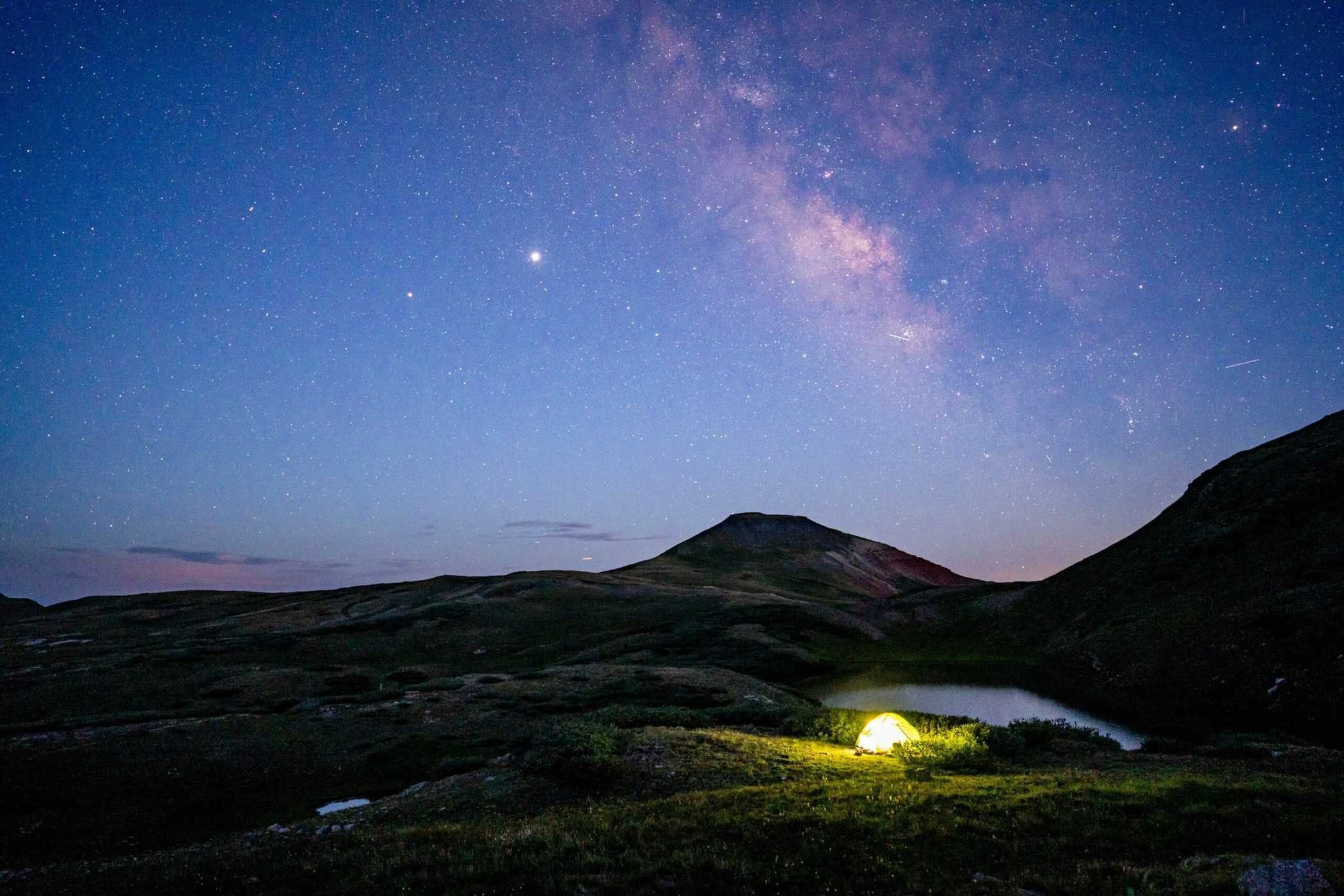
What to look for when buying a backpacking tent
Size
Typically, backpacking tents have a capacity of one to two people. This is indicated by 1P or 2P, respectively. If you’re tall, make sure to check the dimensional specs, like width, height (for head room), and length.
Seasonality
Three-season tents are most common, as much of the backpacking we do happens in peak season (spring to autumn). A three-season tent also tends to be lighter and less expensive when compared to a four-season or expedition tent.
You’ll occasionally also see one-season and two-season tents. These are pretty much identical and make excellent summer shelters, as they’re both breathable and lightweight. That said, their use case is hopelessly restricted to fine weather.
A four-season tent (like the Mountain Hardwear Trango Tent) is a good option if you find yourself doing both three-season and winter backpacking and prefer to have just one tent for all your needs.
Weight
Most backpacking tents will weigh in the range of one pound and five pounds. While it doesn’t seem like much, it certainly feels like a lot after several dozen miles. When it comes to hiking, if you can live with a few less frills, then a lightweight tent is the way to go.
Features
When it comes to tents, there aren’t many features that you necessarily need. However, standard features like internal storage pockets, a bathtub floor, and dynamic ventilation make a good tent even better.
Still unsure how to pick your camping tent? Check out our main article on the subject.
FAQs for backpacking tents
How heavy should a tent be for backpacking?
First, establish what you want out of your tent. Is it just a humble shelter to catch some z’s? Or do you want a little more comfort? Is it for a thru-hike or just a weekend trip? Once you’ve answered these questions, you can better decide how heavy that tent should be. In general, one pound is on the extremely light side, while five pounds and over is on the heavy spectrum.
What's the difference between a camping tent and a backpacking tent?
Simply put, camping is about staying put while backpacking is about moving around. Hence, camping tents tend to have a few more frills at the expense of weight. Conversely, backpacking tents are more minimalist and lightweight, which usually comes at the cost of certain comforts.
How much should I spend on a tent?
As we’ve seen in the product guide above, tents can range dramatically in price. Similar to the question about weight, it depends on what you’re going to use it for. For instance, with a smaller budget, you can get yourself a high-quality summer tent. But, if you need something that'll keep you safe and comfortable in winter weather, it won’t cut it. Now we’re looking at the Trango Tent, which is more than threefold in price.
Do I need to use a footprint with my tent?
Not always. It largely depends on the terrain and the local climate. Nevertheless, using a footprint is highly suggested. At the very least, it’ll keep the floor of your tent from incurring damage over time and provide an extra layer against wet ground.
Conclusion
Whether you’re pedaling through remote gravel trails, trekking deep into the backcountry, or prepping for a winter summit push, there’s an ultralight tent built to match your pace and purpose. From featherweight solo shelters to rugged four-season fortresses, the best ultralight tents of 2025 prove you don’t have to choose between performance and packability.
Still unsure? Start by asking yourself where you’re headed—and how much comfort you’re willing to carry. After that, the right shelter tends to find you.



